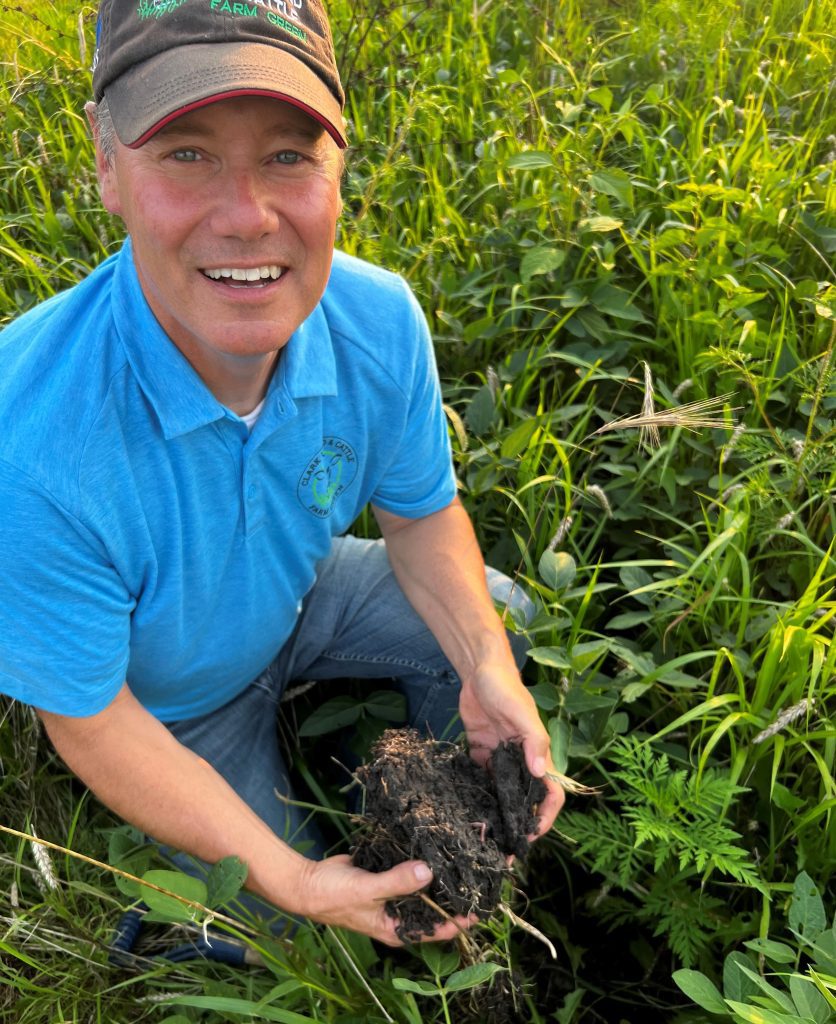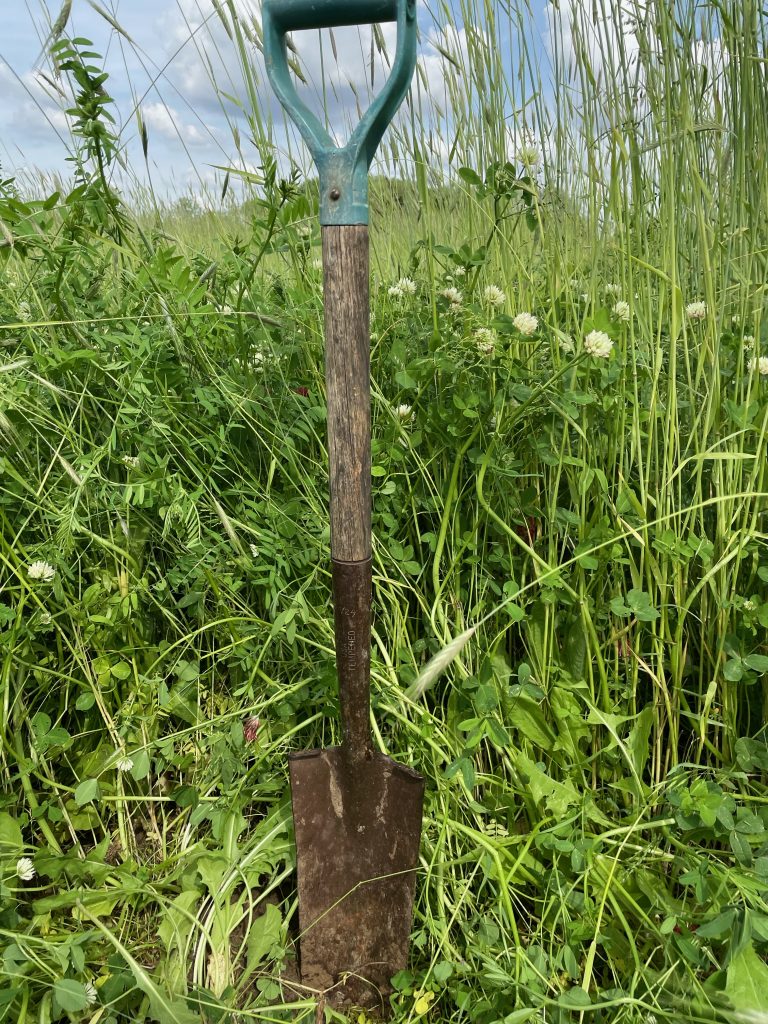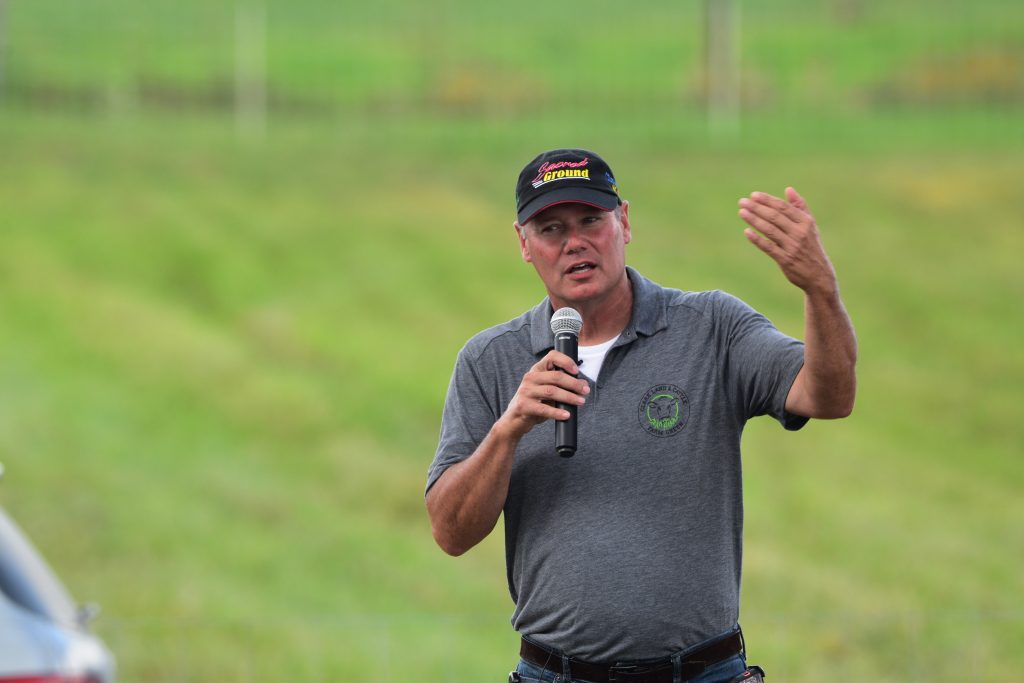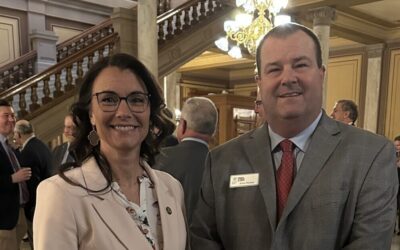Soil erosion led farmer to transform his operation, soil health efforts
By Amie Simpson
One weather event in 2007 completely changed the course of a farming operation in west central Indiana. Rick Clark, a fifth-generation farmer in Warren County, describes a soil erosion event after a one-inch rainfall as a wake-up call.
“We did our normal tillage one day in the spring that year before we had a one-inch rain event. That evening I was driving down the road and slowed down because something was in the road. I soon realized it was soil from our field,” he says. “That’s when I said, ‘it’s time to make a change.’ That’s what got us started down the regenerative agriculture road.”

He began researching cover crops and no-till because of the soil erosion event. Clark says he decided to start with tillage radish, because it has a deep tap root, pulls nutrients to the surface, mitigates compaction, and is a winter-kill cover crop that doesn’t need to be terminated in the spring.
During that planting season, Clark took a 200-acre field and used his typical tillage practices on half and switched to no till into the radish cover crop on the other half.
“At harvest, it was the best yielding field on the farm and the best return on investment. I saw the power of cover crops and started working to get them on acres across the farm right away,” he says. “From there, we started implementing cereal rye cocktails with up to four or five cover crop species in addition to 100 percent no-till. Mother Nature has absolutely guided me where to go, because if that weather storm hadn’t happened that night and moved the field to the road, we may not be here today.”
A systematic approach to regenerative organic farming
Today, the farm is 100 percent organic. Clark has been able to incorporate regenerative farming practices like crop rotation, no-till, cover crops, and elimination of fertilizer and pesticides with all acres being certified organic.
The family’s current rotation includes corn, soybeans, wheat, alfalfa, peas, milo, cover crops, cattle, and sheep.
Clark says he’s seen the benefits of going from traditional tillage 17 years ago to 100 percent no-till to 100 percent cover crops to 100 percent non-GMO, and now 100 percent organic. But, it’s been a process, he says.
Before beginning to transition to organic in 2017, Clark says the operation was the most profitable when the farm was 100 percent non-GMO, 100 percent cover crop, and 100 percent no-till with a 70 percent reduction of fertilizers and pesticides.

“We had the biggest return on investment the farm has ever seen at that time,” he says.
When we first transitioned to organic production there was a 30 percent drop in yield that was balanced by higher crop prices and lower input costs. He transitioned 500 acres to organic in the first year and was 100 percent organic four years later.
“Today we are saving about $500 an acre in input costs. For a farm of our size, it’s getting close to $3,000,000 of input savings per year,” he says. “So, when you look at our system, you begin to understand that I’m not about yield. I’m about saving money on the front end and minimizing risk and then the yield will come on the back end. I don’t need a lot of yield, because not only are we taking inputs to zero, I’m on organic price levels which are double conventional corn and soybean prices. If you want to increase your yield, don’t follow what we’re doing because this is about building soil health, building human health, being a good steward of the land, and being conservation-minded.”
He says concerns about weeds shouldn’t prevent someone from trying organic production.
“The best way we know to mitigate weeds in an organic system is through cover crop suppression. We raise cereal rye and are planting soybeans in the cereal rye at the boot stage. We roll it all down at anthesis and the soybeans come back up and the rye stays down. You’ve now laid a mat down that covers the ground and armors the soil,” he says. “The timing of planting cover crops in the fall also impacts weeds. Cover crops planted in September, for example, may have 40% more biomass and it’s going to hold the weeds back longer than cover crops planted in November. The success of next year’s cash crop starts with the success of this year’s cover crop.”
Stepping out of your comfort zone to reach goals
Advice he has for farmers considering implementing or ramping up conservation efforts is to start small and be prepared to give the practice some time before expecting results.
“This is a minimum of a five-year journey to even think about reducing inputs. My first piece of advice is not to jeopardize the livelihood of the farm. My second piece of advice is to do something that has a high likelihood of success the first time you try it because if it doesn’t work, you’re not going to want to do it again,” he says. “My third piece of advice is not to offend the practices that are currently in place on the farm because this is heritage. This is the way your dad has done it, this is the way your grandfather has done it, and the last thing you want to do is walk in and upset anyone and get them on the defense. It’s all about working together and taking a couple of ideas and bringing those ideas to your farm on a small scale to see how it works.”

Clark says implementing practices to improve soil health can and must be done because the next generation will be impacted if soil degradation continues. His hope is that a farmer interested in improving soil health will take two or three practices and implement them on his or her own farm and give it two or three years before expanding to additional acres.
He encourages farmers to step out of their comfort zone and try something different.
“If you’re not uncomfortable with what you’re doing, then you’re not trying hard enough to change. I challenge everyone to get a little uncomfortable,” he says. “I think you’ll like how it feels.”
He encourages farmers looking for resources to reach out to their local Purdue Extension. He also suggests finding other farmers who are already implementing some of these practices.
Farmers interested in implementing some conservation practices can contact Joe Rorick, the on-farm sustainability programs and research coordinator with the Indiana Soybean Alliance, at jrorick@indianasoybean.com.
Posted: March 22, 2024
Category: Indiana Corn and Soybean Post - March 2024, ISA, News, Sustainability




